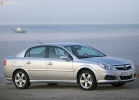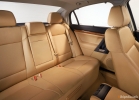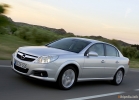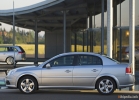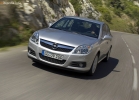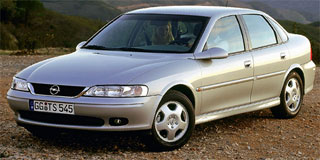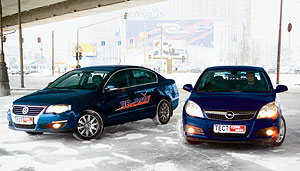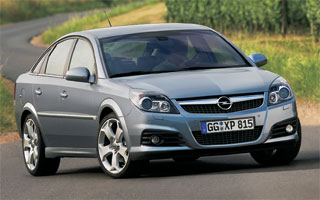Test drive Opel Vectra sedan 2005 - 2008 sedan
The vector of calm success
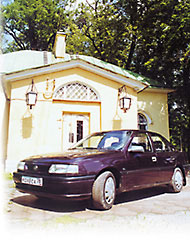 Within the framework of the testing program for the testing of used cars, we introduced our readers to two of the three bestsellers of the St. Petersburg market belonging to the lower middle class (aka Class D), - Volkswagen Passat III models (No. 6 for 99) and Audi 80 (No. 15 for 99). And today our collection will be replenished with the third super popular character.
Within the framework of the testing program for the testing of used cars, we introduced our readers to two of the three bestsellers of the St. Petersburg market belonging to the lower middle class (aka Class D), - Volkswagen Passat III models (No. 6 for 99) and Audi 80 (No. 15 for 99). And today our collection will be replenished with the third super popular character. It just so happened that in our country the volume of sales of used foreign cars is several times superior to sales of new foreign cars, and the names of favorites are both among the first and the latter literally everyone. Within the framework of the testing program of used cars, we introduced our readers to two of the three bestsellers of the St. Petersburg market belonging to the lower middle class (aka Class D), - Volkswagen Passat III (N6'99) and AUDI 80 (N15'99) . And today our collection will be replenished with the third super popular character.
Story.
The name of this car does not mean absolutely nothing - it was one of the first in world practice was synthesized on the computer. In any case, this was stated by representatives of Adam Opel AG. Nevertheless, it is most directly echoing with a very capacious mathematical term vector. Opel Vectra replaced the outdated ASCONA model on the conveyor of the plant in RUSESLSHAM in the summer of 1988, and soon the production of a car under the VAUXHALL brand began in the British Luton (by the way, our subjected will be carried on the radiator’s grille precisely the Vokollov emblem, although it is a true Aryan). In the same fall, the car won the silver of the European contest of the 1989 car.
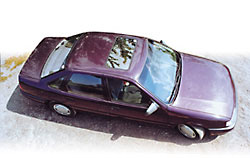 At first, Vectra was equipped with gasoline engines with a volume of 1.4-2.0 liters and a 1.7-liter diesel engine. Powerful modifications, including with a six -cylinder engine, as well as a version with a drive for all wheels appeared after the modernization of 1992. And the coolest Vectra - with a 204 -horsepower turbo engine and all -wheel drive transmission borrowed from the Calibra compartment - made his debut at the sunset of the model, at the end of 1993. When a second -generation model was born a year and a half later, or Vectra B, General Motors transferred the production of a machine to Brazil, where it was produced for some time under the Chevrolet brand. Over the eight years, the car spread out a total circulation of about two million copies, and for several years in a row it headed the European list of the most popular class Dthoma models. Opel Calibra and Saab 900/9-3 were created on its platform, and in 1995 John Cheren Vauxhall Cavalier won the British Besshall Cavalier Circus Cars.
At first, Vectra was equipped with gasoline engines with a volume of 1.4-2.0 liters and a 1.7-liter diesel engine. Powerful modifications, including with a six -cylinder engine, as well as a version with a drive for all wheels appeared after the modernization of 1992. And the coolest Vectra - with a 204 -horsepower turbo engine and all -wheel drive transmission borrowed from the Calibra compartment - made his debut at the sunset of the model, at the end of 1993. When a second -generation model was born a year and a half later, or Vectra B, General Motors transferred the production of a machine to Brazil, where it was produced for some time under the Chevrolet brand. Over the eight years, the car spread out a total circulation of about two million copies, and for several years in a row it headed the European list of the most popular class Dthoma models. Opel Calibra and Saab 900/9-3 were created on its platform, and in 1995 John Cheren Vauxhall Cavalier won the British Besshall Cavalier Circus Cars. For the sake of objectivity for a detailed acquaintance, we chose a car in the simplest configuration: with a 1.6-liter engine with a injection system, and with the most common body sedan in Russia. This Vectra was released in 1993 and managed to run about 102,000 km in his life.
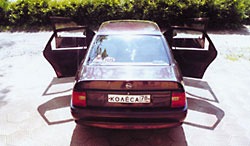 Outside.
Outside. The updated Vectra is outwardly different from the 1988-92 cars. The production of a different design of the radiator grille, to which an enlarged branded emblem moved from the hood cover, a different form of head optics and stained with bumpers (previously this was a prerogative of top modifications). And, I must admit, the changes went to the car only to the benefit. Vectra has already stood out with unusual cars with solidity and design, and devoid of the slightest signs of conservatism: a high trunk line, a sloping roof and rounded rear lateral windows looked very relevant in the late eighties and introduced a note of freshness and dynamism into the appearance of a machine. And the restored Vectra began to look even more respectable. This is not to say that today this Opel is catastrophically outdated - its modest and balanced design has not been endowed with bright, acutely actual features that tend to quickly get out of fashion.
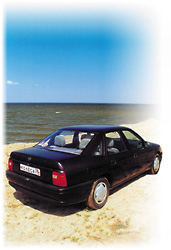 Inside.
Inside. The equipment of this car is basic; Raising the archives, we found out that in 1993 it included: a five -speed manual gearbox, a power steering, a manual hatch, a centralized door control system and folding back seat back.
It is deeply pretty that the creators of the machine in their work were not guided by the principles of strict savings. The interior, although it is sustained in the same balanced style as the exterior, but in its design, high -quality (adjusted for the class belonging of the model) plastic, and most details not only do not leave any doubts about their reliability and strength, but also well thought out From the point of view of ergonomics.
Take at least a driver's place. The seat ideal in shape is equipped with height adjustment, which is carried out by a rotating pen, similar to the one that controls the windows. Upon completion of the process of adjusting the chair (and we performed such an operation under our own 178 and 190 cm) steering wheel, pedals, the gearbox lever is exactly where you expect them to find. And this despite the fact that the position of the steering column cannot be changed here. The lamb is not just successful in geometric parameters, opening the entire dashboard on display - its three -spoke structure can be called the dream of an active driver, because in critical situations it does not prevent speed -speed leafing.
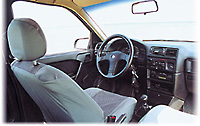 As for the dashboard, it will seem primitive to many of its black and white gamut; In fact, this sensation creates the absence of a tachometer. But the readability of the remaining three signs, clearly digitized and not overloaded with small scales, can be safely brought as an example and entered into the Annals of the automotive industry as it should.
As for the dashboard, it will seem primitive to many of its black and white gamut; In fact, this sensation creates the absence of a tachometer. But the readability of the remaining three signs, clearly digitized and not overloaded with small scales, can be safely brought as an example and entered into the Annals of the automotive industry as it should. A number of elements, such as the handle of the head of the head of the head light or the spring -loaded handrails at the top, immediately gives out the creation of the German engineering school in the vector. Although there are also misses that are universally respected school. First of all, we are talking about stupid and, as it seems, a blindly blind ventilation control unit, and the distance between the front seats should have been done more. However, we repeat: there are still much more pluses than
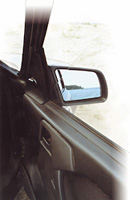 minuses. For example, it is impossible to make any complaints to the mutual placement of pens and handrails on the inside of the doors, and two regiments -containers - one in the central console, the other above the glove box - coupled with the latter to combine any useful or useless trifle in the road.
minuses. For example, it is impossible to make any complaints to the mutual placement of pens and handrails on the inside of the doors, and two regiments -containers - one in the central console, the other above the glove box - coupled with the latter to combine any useful or useless trifle in the road. An unexpected and pleasant surprise was the scope with which the car meets the rear passengers, first of all, it concerns space in the legs. Even sitting behind tall people, they will not feel special constraint. And what is especially important - this level of comfort will not be achieved due to the vertical setting of the back of the rear sofa. By the way, a pair of head restraints serves as a clear sign that the most convenient will be two riders here; A trifle option will be made only for intracity trips.
The back of the seat, as promised by the equipment of the machine, is made, which is formed, both in an unequal proportion (1: 3 or 2: 3), and entirely, which removes many issues related to transportation of objects of non -standard dimension. But, of course, the practicality of the hatchback, and Vectra was produced with such a body, is not in sight here. The luggage compartment has the optimal shape of the opening, while we attributed strongly protruding wheel arches and the trunk lid, any contact with which in the dirty season will certainly lead to loss of sterility of the palms.
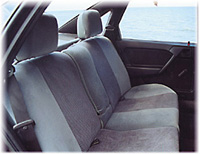 In move.
In move. Seventy -five horsepower for a plain car is a very modest indicator, but Vectra does not claim any sports. The 1.6 -liter engine has a good supply of torque on the bottom, so it is a pleasure to move from a place, and the early shifts for increased gear forgive the motor. However, it spins quite sluggishly, showing the greatest edification when exiting high speeds. A box with stretched transfer numbers is also contributed to the far from brilliant dynamics; On the other hand, this will like connoisseurs of a comfortable driving - after all, there is no particular need to wield a gearbox lever, and a convenient platform is provided at the disposal of the left leg. A few words about the work of the gearbox itself: Switching upwards occur clearly, and when the low transmission is turned on, you sometimes have to make certain efforts.
The drives of all pedals, without exception, are quite informative, the remark is only on the large free stroke of the brake pedal, but this does not spoil the general good impression of the brake system - it does not spoil the habit.
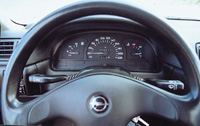 Due to the good overview of the driver's place (only the rear headrests limit it, but the presence of these important means of passive safety must be taken for granted) maneuvering in the traffic stream is greatly simplified. The steering is ideally adapted for the standard traffic modes: the hydraulic power control provides an excellent reactive force in almost the entire range of corners of rotation of the steering wheel, with the exception of the smallest. In high -speed turns, Vectra demonstrates the expected insufficient rotation, and the most important thing - even with the demolition of the front axle, the car remains controlled, and with simple corrective actions it is easy to return to the true path. A more aggressive riding reveals other controllability features - this is also the insufficient performance of the hydraulic pump pump, leading to a bite of the steering wheel at its sharp turns to large angles, and sometimes lubricated the reaction of the driver to the driver’s actions. In addition, in the turns of Vectra, it is poorly fraught with, preferring early to slip, - however, it is necessary to blame not so much the design of the car as the characteristics of the tires. But how often do we have to ride so risky?
Due to the good overview of the driver's place (only the rear headrests limit it, but the presence of these important means of passive safety must be taken for granted) maneuvering in the traffic stream is greatly simplified. The steering is ideally adapted for the standard traffic modes: the hydraulic power control provides an excellent reactive force in almost the entire range of corners of rotation of the steering wheel, with the exception of the smallest. In high -speed turns, Vectra demonstrates the expected insufficient rotation, and the most important thing - even with the demolition of the front axle, the car remains controlled, and with simple corrective actions it is easy to return to the true path. A more aggressive riding reveals other controllability features - this is also the insufficient performance of the hydraulic pump pump, leading to a bite of the steering wheel at its sharp turns to large angles, and sometimes lubricated the reaction of the driver to the driver’s actions. In addition, in the turns of Vectra, it is poorly fraught with, preferring early to slip, - however, it is necessary to blame not so much the design of the car as the characteristics of the tires. But how often do we have to ride so risky? 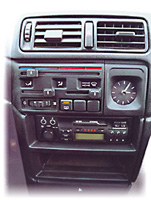 The suspension successfully fights cracks, pits and pits, and at the same time painfully reacts to convex irregularities. At the joints and spaces, the body is pretty thrown, and the shocks and blows are transferred to the steering wheel. In general, the smoothness of the machine can be evaluated as very good, especially against the background of German classmates of the same time period.
The suspension successfully fights cracks, pits and pits, and at the same time painfully reacts to convex irregularities. At the joints and spaces, the body is pretty thrown, and the shocks and blows are transferred to the steering wheel. In general, the smoothness of the machine can be evaluated as very good, especially against the background of German classmates of the same time period. But the vibro and noise insulation of the car are more mediocre. In the cabin, there is constantly the sound of the engine, and at medium and high speeds there is also the noise of the tires, and the noise of an air flow. We have already talked about the sensitive to the state of the road surface.
Summary.
Since this year, Vectra has been bent for twelve years, - an venerable age - it will be easier to evaluate it not in the absolute, but in comparison with eternal rivals, Audi 80 and Volkswagen Passat III. Audi has the most assertive design and the best handling in maximum modes, but it has the hardest suspension, as well as uncomfortable rear seats and trunk. Passat is the most spacious, but its design causes the most discussions. Vectra is the most calm car, both in style and in temperament, and from the whole trinity stands out with the best smoothness. In addition, with a 75-horsepower engine, he will willy-nilly becomes calm and leisurely. But this also has its own positive points: firstly, used machines in this configuration are of the least wear, and secondly, they have less fuel consumption. Finally, in the system of values \u200b\u200bof many car owners, dynamic parameters occupy in importance not the first place at all. So the choice is for you.
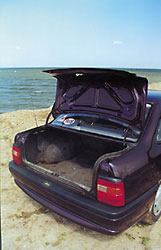
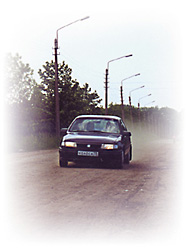
Source: Wheel magazine [No. 41/2000]

